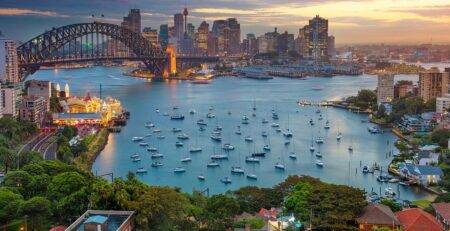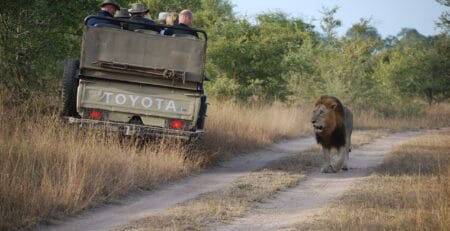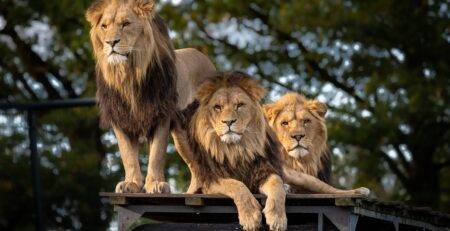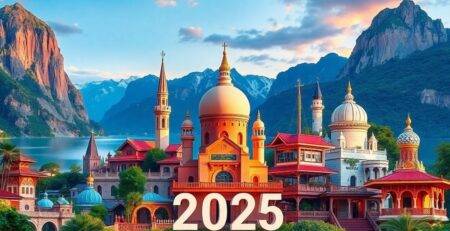As I plan my adventures for next year, I’ve been looking into some incredible African safari destinations that are really starting to shine. While the famous spots like the Mara and Serengeti are amazing, I’m always on the lookout for places that offer something a bit different, maybe fewer crowds and a more raw experience. For 2025, I’ve found a few emerging safari destinations that I think are going to be big. It’s exciting to think about exploring these less-traveled paths and seeing what wildlife wonders they hold. I’m putting together this list to share some of my top picks for emerging safari destinations 2025.
Key Takeaways
- For 2025, I’m focusing on emerging safari destinations that offer unique experiences beyond the usual tourist trails.
- Ruaha National Park in Tanzania is a top pick for its large elephant herds and wild dog sightings, providing a wilder feel.
- South Luangwa National Park in Zambia is highlighted for its walking safaris and abundant wildlife, offering a more traditional yet less crowded experience.
- The Okavango Delta in Botswana is noted for its diverse ecosystems and unique water-based safaris, perfect for a different kind of adventure.
- Laikipia in Kenya is emerging as a conservation success story, great for rhino and Grevy’s zebra sightings with fewer visitors. emerging safari destinations 2025
1. Ruaha National Park

I recently had the chance to visit Ruaha National Park in Tanzania, and honestly, it blew me away. It’s massive, way bigger than I even imagined, and yet, it feels so untouched. This place is Tanzania’s best-kept secret, and I can see why. It’s not like the Serengeti where you’re constantly bumping into other vehicles. Here, it feels like you have the whole park to yourself, which makes the wildlife sightings that much more special.
Wildlife Spectacle
Ruaha is famous for its sheer numbers of animals, and I wasn’t disappointed. I saw the largest elephant herds I’ve ever encountered, just massive groups of them. The predators are here in force too. I got lucky and saw lions, leopards, and even some of the highly endangered wild dogs. It’s a really wild place, perfect if you’re looking for something off the usual path. emerging safari destinations 2025
What Makes Ruaha Stand Out
- Vastness and Exclusivity: Its sheer size means fewer lodges and a more private experience.
- Abundant Wildlife: Home to huge elephant herds and a good chance to see wild dogs.
- Predator Paradise: Excellent sightings of lions and leopards are common.
- Stunning Scenery: The landscapes are dramatic, with rugged hills and the Great Ruaha River.
Planning Your Ruaha Adventure
- Best Time to Visit: The dry season, from June to October, is ideal as animals gather near water sources.
- Getting There: Usually involves a flight from Dar es Salaam or other major hubs.
- Accommodation: Options range from rustic camps to more luxurious lodges, but they are few, adding to the exclusivity.
Ruaha offers a raw, untamed safari experience that’s hard to find elsewhere. It’s a place where you feel truly immersed in the African wilderness, far from the crowds. I’d recommend it to anyone looking for a genuine adventure.
2. South Luangwa National Park

When I think about authentic safari experiences, South Luangwa National Park in Zambia immediately comes to mind. It’s often called the birthplace of the walking safari, and for good reason. I mean, experiencing the bush on foot, with just a guide and the sounds of nature around you, is something else entirely. It really changes your perspective on everything. You notice the small things, like the tracks of a leopard or the scent of wild sage, that you might miss from a vehicle. emerging safari destinations 2025
The Walking Safari Capital
South Luangwa is famous for its walking safaris, and I can see why. You can do anything from a short morning stroll to multi-day treks between camps. It’s a chance to really connect with the environment. The guides here are incredibly knowledgeable; they grew up in the area and know the bush like the back of their hand. They can spot things I would never even see.
Wildlife Density
The sheer amount of wildlife in South Luangwa is impressive. I saw huge herds of elephants and buffalo, lots of giraffes, and plenty of antelope. The predators are here too – lions, leopards, and the endangered wild dog. It’s not uncommon to see four of the Big Five, though rhinos are absent. emerging safari destinations 2025
Why South Luangwa for 2025?
For my South Luangwa safari 2025, I’m looking forward to the park’s raw beauty and the fact that it doesn’t get as crowded as some of the more famous parks. It feels more wild and untouched. Plus, the quality of guiding is top-notch, which makes a huge difference to the overall experience. It’s a place that safari connoisseurs return to again and again.
The park’s river systems and lagoons attract a massive concentration of animals, especially during the dry season. This makes for incredible game viewing opportunities, whether you’re on foot or in a vehicle.
Key Highlights
- Exceptional Guiding: The guides are the heart of the South Luangwa experience.
- Walking Safaris: The best way to truly immerse yourself in the bush.
- High Wildlife Concentrations: Expect to see a lot of animals, especially around water sources.
- Leopard Hotspot: South Luangwa is renowned for its leopard sightings.
If you’re looking for a truly immersive and authentic safari, I’d definitely put South Luangwa on your list. It offers a different kind of magic compared to the more well-trodden paths. You can find some really special bushcamps in the southern region that offer a more intimate experience.
3. Okavango Delta

When I think about truly unique safari experiences, the Okavango Delta in Botswana immediately comes to mind. It’s not just another savanna; it’s a massive inland delta, a place where desert meets water in the most spectacular way. This UNESCO World Heritage Site is a bit different from the usual game drives, though you can certainly do those. What really sets it apart for me are the mokoro safaris. Gliding silently through the waterways in a traditional dugout canoe, with reeds rustling and the sounds of the bush all around you, is an experience I won’t soon forget.
What to Expect
- Unique Waterways: The Delta is famous for its seasonal floods, which transform the landscape and create incredible wildlife viewing opportunities. You can explore these channels by mokoro or motorboat.
- Diverse Wildlife: While you can find the Big Five here (including rhinos in certain areas like Moremi Game Reserve), the Delta is also home to vast herds of elephants, hippos, and a fantastic array of birdlife. It’s a birdwatcher’s paradise.
- Exclusive Camps: Many of the camps are quite remote and accessible only by light aircraft, which adds to the feeling of exclusivity and adventure. This means fewer crowds and a more intimate wildlife encounter.
Best Time to Visit
For the best water levels and the highest concentration of wildlife, I’d aim for the dry season, typically from May to September. This is when the floodwaters arrive, concentrating animals around the permanent water sources.
Activities
- Mokoro Safaris: My absolute favorite way to see the Delta. It’s peaceful and offers a different perspective on the wildlife.
- Game Drives: Classic safari drives on land to spot predators and other terrestrial animals.
- Walking Safaris: Guided walks allow you to appreciate the smaller details of the bush and learn about tracking.
The Okavango Delta offers a safari experience that feels both wild and incredibly serene. It’s a place where the rhythm of the water dictates the flow of life, and witnessing that firsthand is something special. It’s definitely a destination that deserves a spot on any serious safari-goer’s list, and I’m already planning my return trip.
If you’re looking for budget-friendly travel options in Africa, it’s worth noting that while the Okavango Delta is a premium destination, there are many cheapest countries to visit in 2025 that offer incredible value and equally memorable adventures.
4. Laikipia

When I think about Kenya, my mind usually goes straight to the Maasai Mara, and for good reason. But there’s this other place, Laikipia, that’s really been catching my eye lately. It’s up in the high plains, kind of northeast of the Great Rift Valley, and it’s becoming known as one of Kenya’s best-kept secrets. I read that it’s almost as big as Wales, which is wild to think about for a safari destination.
What really got me interested, though, are the conservation stories coming out of Laikipia. Places like the Lewa Wildlife Conservancy are doing amazing work, especially with rhinos – both black and white – and Grevy’s zebra. It sounds like the kind of place where you can actually see these animals without a ton of other people around. Apparently, visitor numbers are pretty low, and there are some really nice lodges and camps that are good for families too. So, if you’re looking for a safari in 2025 and want to avoid the crowds, Laikipia conservancy Kenya might be just the ticket.
Why Laikipia Stands Out
- Conservation Focus: It’s a hub for conservation efforts, particularly for endangered species like rhinos and Grevy’s zebras.
- Low Visitor Numbers: You’re likely to have a more private and intimate safari experience.
- Diverse Activities: Beyond game drives, expect opportunities for walking safaris and night drives, which aren’t always available elsewhere.
- Stunning Scenery: The high plains offer beautiful landscapes, perfect for those sundowner moments.
I’ve heard that the lack of dense vegetation compared to some other parks means you have really clear views of the wildlife. It sounds like a photographer’s dream, honestly.
What to Expect in Laikipia
| Wildlife Highlight | Conservation Success | Activities |
|---|---|---|
| Black Rhino | Grevy’s Zebra Sanctuary | Game Drives |
| White Rhino | Rhino Ark | Walking Safaris |
| Reticulated Giraffe | Big Life Foundation | Night Drives |
| African Wild Dog | Northern Rangelands Trust | Camel Safaris |
5. Amboseli National Park

Iconic Kilimanjaro Views
When I think of Amboseli National Park, the first thing that comes to mind is the absolutely breathtaking backdrop of Mount Kilimanjaro. It’s not just a mountain; it’s this massive, snow-capped presence that makes every photo pop. Seriously, if you’re into photography safari tours 2025, this place is a dream. The park itself is famous for its huge elephant herds, and seeing them wander across the plains with Kilimanjaro looming in the background is something else. I’ve always wanted to do a proper walking safari Africa experience, and Amboseli offers that too, allowing you to get closer to nature. emerging safari destinations 2025
Wildlife Hotspots
Amboseli is a real gem for wildlife. Beyond the elephants, you can spot lions, cheetahs, giraffes, and zebras. Plus, there are over 400 species of birds, which is pretty wild. The park’s mix of dry areas and swamps means there’s always something moving around. It’s definitely one of those eco safari destinations Africa can be proud of. The best time to visit is usually during the dry season, from June to October, when the animals tend to gather near the water sources, making spotting them a bit easier. emerging safari destinations 2025
Planning Your Visit
When planning your trip for 2025, consider visiting during the dry months of June to October. This period offers the best chances for wildlife sightings and clearer views of Kilimanjaro. For those interested in photography, the early morning and late afternoon light is magical. You can find some amazing African safari tours that include Amboseli, often combining it with other Kenyan highlights. It’s a place that truly lives up to its reputation.
10 Safari Tips Every Traveler Should Know Before Setting Out
6. Tsavo National Park

When I think about Tsavo, the first thing that comes to mind is the sheer scale of it. Tsavo East and West together make up one of the largest park areas in Kenya, and honestly, it feels that way when you’re there. It’s a place that really gives you a sense of wild, open space. I remember driving through Tsavo East, and it just seemed to go on forever, with these vast, arid plains stretching out under a huge sky. It’s famous for its red elephants, which get their color from the local soil. Seeing them dusted in that reddish-brown dust is quite a sight.
Wildlife Highlights
While Tsavo might not always have the super-high densities of animals you find in some other parks, it’s still packed with incredible wildlife. I’ve had some amazing sightings here, especially of elephants, which are plentiful. You can also spot lions, cheetahs, leopards, and various antelopes. The birdlife is pretty good too, especially around the water sources. emerging safari destinations 2025
Best Time to Visit
I usually plan my trips to Tsavo during the dry seasons. The period from July to October is fantastic because the wildlife tends to gather around the remaining waterholes, making them easier to find. Another good window is from December to February. The weather is generally pleasant, and the dry conditions make spotting animals a bit simpler.
Key Attractions
- Yatta Plateau: This is the world’s longest lava flow, and it’s a really unique geological feature. I found it fascinating to walk along parts of it.
- Mzima Springs: Located in Tsavo West, these are crystal-clear springs that form a vital water source. You can even view the underwater life from a glass-observatory.
- Lugard Falls: These are a series of white-water rapids on the Galana River, and they’re quite dramatic, especially after rain.
Tsavo is a vital area for Kenya’s wildlife, particularly for elephants and rhinos. The conservation efforts here are really important for protecting these animals and their habitats. It’s a place where you can really feel the raw beauty of the African wilderness. emerging safari destinations 2025
I found that Tsavo offers a different kind of safari experience compared to some of the more crowded parks. It feels more rugged and less manicured, which I personally enjoy. It’s a great place to explore if you’re looking for that classic, expansive African landscape and want to see wildlife in a more natural, less managed setting. You can find more information on the Kenya Wildlife Service website.
7. Nyerere National Park

When I think about Tanzania, my mind usually goes straight to the Serengeti or Ngorongoro, but I’ve been hearing a lot about Nyerere National Park lately, and it sounds like a real gem. It used to be part of the Selous Game Reserve, but it’s now its own national park, and it’s massive – like, bigger than Switzerland massive. What really sets it apart for me is the Rufiji River. It’s the park’s lifeblood, creating these cool lakes and channels that are just packed with hippos and crocodiles. Plus, you get these huge herds of elephants and tons of birds.
What’s really interesting is that because it’s not under the same rules as some of the other parks, you can do things like guided walking safaris and even fly-camping. I’m all about getting off the beaten path, so that sounds pretty amazing. It’s definitely a different vibe from the more famous spots, and I’m curious to see how it compares. It feels like a place where you can really experience the wild without as many crowds. I’m definitely adding this to my list for a future trip, maybe after I check out some of the South African safari options.
Activities
- Boat cruises: Cruising along the Rufiji River is a must-do. You get to see hippos, crocs, and lots of birdlife right from the water.
- Walking safaris: This is a big draw for me. Being able to explore on foot with a guide offers a totally different perspective on the bush.
- Game drives: Of course, you can still do traditional game drives to spot the usual suspects like elephants, lions, and wild dogs.
Best Time to Visit
I’ve read that the dry seasons, from June to September and then again from December to February, are the best times to go. That’s when the wildlife tends to gather around the water sources, making them easier to spot.
Wildlife Highlights
Nyerere is known for its large elephant herds and a good number of hippos and crocodiles. It’s also a great place for spotting predators like lions and wild dogs, and the birdlife is supposed to be incredible, especially along the river.
This park offers a wilder, more remote experience compared to some of Tanzania’s more popular destinations. It’s a place for those who appreciate vast landscapes and a sense of true wilderness.
8. Queen Elizabeth National Park
When I think about Uganda, Queen Elizabeth National Park immediately comes to mind. It’s often called the Pearl of Africa’s premier game viewing spot, and I can see why. The landscape here is just wild – you get these wide-open savannas, but then it shifts to wetlands and even some dense forest. It’s this mix that makes it so special, I think. emerging safari destinations 2025
Wildlife Highlights
I was really hoping to see the famous tree-climbing lions in the Ishasha sector, and while they can be a bit elusive, the chance is definitely there. Beyond them, the park is packed with elephants, buffaloes, and leopards. It’s also a birdwatcher’s paradise; I read it has over 600 species, which is just mind-boggling. Imagine seeing that many different kinds of birds!
Kazinga Channel Boat Cruise
One thing I absolutely have to do is take a boat cruise on the Kazinga Channel. Apparently, it’s where you get up close (but safely, of course) to huge pods of hippos, crocodiles, and so many water birds. It sounds like a really relaxed way to see a lot of the park’s inhabitants without all the bumping around of a game drive. It’s definitely a highlight for many visitors. emerging safari destinations 2025
Best Time to Visit
From what I’ve gathered, the dry seasons are the sweet spot for visiting. That’s usually from June to September and then again from December to February. During these times, the animals tend to gather more around water sources, making them easier to spot. Plus, the park roads are generally more accessible.
Planning a safari involves a bit of preparation. It’s a good idea to pack light, water-resistant luggage. Knowing a few basic Swahili phrases, like “Habari” for hello and “Asante” for thank you, can really make interactions smoother with the local guides and staff. It’s also customary to show appreciation through tips.
Activities Beyond Game Drives
While game drives are the main event, Queen Elizabeth offers more. There’s the chance for guided nature walks, and for the truly adventurous, exploring the Kyambura Gorge is an option. It’s a bit of a trek, but the scenery and the chance to see chimps are supposed to be worth it. I’m still deciding if I’m up for that kind of hike, but it’s good to know the options are there. For anyone planning a trip, checking out Uganda’s national parks is a great starting point. emerging safari destinations 2025
9. Bwindi Impenetrable National Park
Gorilla Trekking
When I think about unique safari experiences, Bwindi Impenetrable National Park in Uganda immediately comes to mind. It’s not your typical savanna drive, that’s for sure. This place is a UNESCO World Heritage site, and for good reason. It’s home to nearly half of the world’s remaining mountain gorillas, and getting to see them in their natural habitat is something else entirely. I booked my permit well in advance, which I’d recommend doing since they can sell out. The trek itself can be pretty demanding, involving hiking through dense forest, so being reasonably fit helps. But honestly, the moment you encounter a gorilla family, all the effort melts away.
Biodiversity Beyond Gorillas
While the gorillas are the main draw, Bwindi is packed with other wildlife too. I was surprised by the sheer variety of life here. There are over 120 mammal species, including forest elephants and various antelopes, though spotting them can be tricky in the thick forest. For birdwatchers, this place is a paradise. I counted over 350 bird species, and the chance to see rare forest birds was a real highlight for me. It’s a different kind of wildlife viewing, more about patience and observation than spotting herds across an open plain.
Cultural Encounters
Beyond the wildlife, I found the cultural aspect of Bwindi really enriching. The park is home to the Batwa people, indigenous forest dwellers. Spending time with them and learning about their traditional way of life, how they used to live in and with the forest, was a powerful experience. It offered a different perspective on the park and its history.
Planning Your Visit
When I went, I aimed for the dry seasons, which are generally June to September and then again from December to February. The trails are much easier to manage during these times. Accommodation options range from basic campsites to more comfortable lodges just outside the park boundaries. It’s a good idea to combine a trip here with other Ugandan parks like Queen Elizabeth for a more varied safari experience.
Permit Cost: $700 (as of my visit)
Best Time to Visit: June-August, December-February
Key Activities: Gorilla Trekking, Birdwatching, Cultural Visits
10. Volcanoes National Park
When I think about truly unique wildlife encounters, Volcanoes National Park in Rwanda immediately comes to mind. It’s not your typical savanna safari, and that’s exactly what makes it so special. This place is famous for being one of the best spots on the planet to see mountain gorillas in their natural environment. I mean, imagine trekking through misty, dense forests and then coming face-to-face with these incredible, gentle giants. It’s an experience that really stays with you.
But it’s not just about the gorillas. I also had the chance to see golden monkeys here, which are just as rare and fascinating. The park is situated in the Virunga Mountains, and the scenery itself is just breathtaking – all rolling hills and lush greenery. It’s a photographer’s dream, honestly.
Gorilla Trekking Experience
My gorilla trek was something else. You need to be prepared for a bit of a hike through the forest, and the terrain can be challenging, but it’s absolutely worth it. The permits are limited, so booking ahead is a must. I found that planning my trip around the dry seasons, generally June to September and again from December to February, made the trekking conditions much easier. It’s a good idea to check out resources for planning your gorilla trekking adventure in Rwanda, as there’s a lot of helpful information out there.
Golden Monkey Tracking
Besides the gorillas, tracking the golden monkeys was another highlight for me. They’re quite active and playful, and watching them in their habitat is just pure joy. It’s a different kind of trek than the gorillas, often a bit less strenuous, but equally rewarding. The park has specific areas where these monkeys are habituated, making for reliable sightings.
Conservation Efforts
It’s really inspiring to see the conservation work happening here. The success in protecting the mountain gorillas is a testament to dedicated efforts. Knowing that my visit contributes to these conservation programs makes the whole experience even more meaningful. It’s a delicate balance, and the park does a great job of managing tourism to protect the wildlife.
Best Time to Visit
I’d recommend visiting during the dry seasons, which are typically from June to mid-September and then again from December to February. During these times, the trails are less muddy, and the weather is generally more pleasant for trekking. Plus, wildlife sightings tend to be a bit easier when water sources are more concentrated.
Volcanoes National Park offers a profound connection with nature. It’s a place where you can witness the power of conservation firsthand and have an encounter that’s truly life-changing. I felt a real sense of awe being so close to these magnificent creatures in their natural home.
Explore the amazing landscapes of Volcanoes National Park! Imagine hiking through lava fields and seeing incredible volcanic craters. It’s a truly unforgettable experience. Want to plan your own adventure? Visit our website to discover more about this breathtaking destination and start planning your trip today!
So, Where Will Your 2025 Safari Take You?
After looking at all these amazing places, I’m really excited about the possibilities for 2025. While the famous spots like the Mara and Serengeti will always be special, it’s clear there’s so much more to explore. From the wilder corners of Tanzania to the unique landscapes of Kenya’s less-traveled areas, Africa keeps surprising me. It feels like there’s always a new adventure waiting, a different animal to see, or a new community to connect with. I’m already thinking about which of these incredible destinations I’ll be booking for my next trip. Africa truly has a way of calling you back.
Frequently Asked Questions
Which Tanzanian park should I visit if I want a less crowded experience?
I think Ruaha National Park in Tanzania is a fantastic choice for 2025. It’s Tanzania’s largest park, but it’s not as crowded as some other famous spots. I found that this means you get to see more animals, like huge elephant herds and rare wild dogs, without a lot of other people around. It feels really wild and special.
What’s a great park for walking safaris and seeing leopards?
For me, South Luangwa National Park in Zambia is a must-see, especially if you enjoy walking safaris. I loved how close you could get to the animals on foot. It’s known for having lots of wildlife, including four of the Big Five, and they say it’s one of the best places for leopard sightings.
What makes the Okavango Delta a special safari destination?
The Okavango Delta in Botswana is truly unique. I was amazed by the mix of water and land safaris. You can go on regular game drives, but also explore the waterways in a mokoro, which is like a canoe. It’s home to so many different kinds of animals because of the water.
Where can I go in Kenya for conservation efforts and fewer crowds?
Laikipia in Kenya is a real hidden gem, in my opinion. It’s not as famous as the Maasai Mara, but it’s doing great work for conservation, especially for rhinos and Grevy’s zebras. I found it to be a peaceful place with fewer tourists, making it perfect for a relaxed family safari.
Which park offers amazing elephant sightings with a famous mountain backdrop?
For me, Amboseli National Park in Kenya is incredible because of the elephants! You can see large herds with Mount Kilimanjaro in the background, which is a breathtaking sight. I found the wildlife viewing to be great there, and it’s a popular spot for photographers.
When is the best time to see the Great Migration, and what are my options if I want fewer crowds?
When I plan my safaris, I always look at the best time to see specific animals. For the Great Migration, I know that the Serengeti in Tanzania and the Maasai Mara in Kenya are the best places to be, usually between July and October. However, for fewer crowds, I might consider visiting during the ‘Green Season’ when new baby animals are born, even if spotting animals can be a bit harder.











